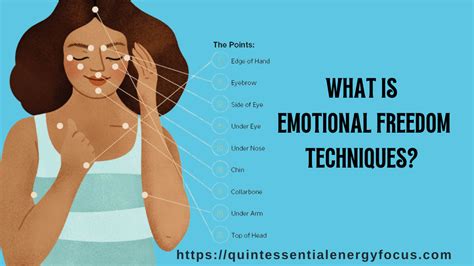Emotional Freedom Techniques, commonly referred to as EFT, is a self-help method that has been gaining popularity over the past few decades. Developed by Gary Craig in the 1990s, EFT is based on the idea that the body’s energy system plays a crucial role in our emotional and physical well-being. By tapping specific points on the body, EFT practitioners believe that they can release blockages in the energy system, thereby reducing stress, anxiety, and other negative emotions.
The concept of EFT is rooted in the principles of acupuncture, which suggests that the body has a complex network of energy pathways, or meridians, that flow through it. According to EFT, when our emotions become imbalanced, it can disrupt the flow of energy through these meridians, leading to a range of physical and emotional symptoms. By tapping specific points along these meridians, EFT practitioners aim to restore the balance of energy and promote emotional freedom.
One of the key benefits of EFT is its simplicity. The technique involves tapping specific points on the body, typically on the face, upper torso, and hands, while focusing on a specific issue or emotion. The tapping sequence is usually performed in a specific order, starting with the karate chop point on the side of the hand, followed by the top of the head, eyebrow point, side of the eye, under the eye, under the nose, chin point, collarbone point, and under the arm. Each point is tapped 5-7 times, while the practitioner repeats a specific phrase or mantra related to the issue at hand.
Despite its simplicity, EFT has been shown to be effective in reducing stress, anxiety, and other negative emotions. Studies have demonstrated that EFT can decrease cortisol levels, heart rate, and blood pressure, while improving mood and cognitive function. EFT has also been used to treat a range of conditions, including post-traumatic stress disorder (PTSD), depression, and chronic pain.
However, EFT is not without its critics. Some have questioned the lack of scientific evidence supporting the technique, while others have raised concerns about its potential to be used as a replacement for conventional medical treatment. While EFT can be a useful complementary therapy, it should not be used as a substitute for medical care.
Pros of EFT:
- Simple and easy to learn
- Can be done anywhere, at any time
- Low cost or no cost
- Can be used in conjunction with other therapies
Cons of EFT:
- Lack of scientific evidence supporting its effectiveness
- May not be suitable for everyone, particularly those with severe mental health conditions
- Requires commitment and practice to see results
- May not address underlying causes of emotional issues
To get the most out of EFT, it’s essential to find a qualified practitioner or instructor who can guide you through the technique. With regular practice and patience, EFT can be a powerful tool for promoting emotional freedom and well-being.
Getting Started with EFT:
- Find a qualified EFT practitioner or instructor
- Learn the basic tapping sequence and technique
- Identify the issues or emotions you want to work on
- Start with short, regular practice sessions (10-15 minutes)
- Gradually increase practice time and frequency as you become more comfortable with the technique
As with any self-help technique, it’s crucial to approach EFT with an open mind and a critical perspective. While EFT may not be a magic solution for all emotional issues, it can be a valuable addition to your self-care toolkit.
What is EFT, and how does it work?
+EFT, or Emotional Freedom Techniques, is a self-help method that involves tapping specific points on the body to release emotional blockages and promote energy balance. The technique is based on the principles of acupuncture and aims to restore the flow of energy through the body's meridians.
What are the benefits of EFT, and what conditions can it be used to treat?
+EFT has been shown to reduce stress, anxiety, and other negative emotions, while improving mood and cognitive function. It has been used to treat a range of conditions, including PTSD, depression, and chronic pain. However, it's essential to consult with a healthcare professional before using EFT as a treatment for any medical condition.
How do I get started with EFT, and what resources are available?
+To get started with EFT, find a qualified practitioner or instructor who can guide you through the technique. You can also find a range of online resources, including tutorials, videos, and eBooks, that can help you learn the basics of EFT and start practicing.
In conclusion, EFT is a simple yet powerful self-help technique that can be used to promote emotional freedom and well-being. While it may not be a substitute for conventional medical treatment, EFT can be a valuable addition to your self-care toolkit. With regular practice and patience, you can experience the benefits of EFT for yourself and start living a more balanced, emotionally free life.



